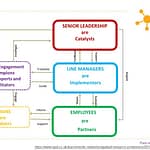In the recent Greater Birmingham (Global) Area Network session with Sallie Allen looking at the role of Virtual Reality in employee engagement, 80% of our participants who voted in the event agreed that VR can be used to engage people returning to work. They also shared some great ideas for the types of experiences that could be built.
When asked –
How could VR be used to engage people returning to work?
– the event participants suggestions included:
- Trying out different ways of working
- A tour around the place of work to see what will be different before returning to work
- To encourage customers back into the business
- Immersive training when doing something for the first time
Virtual Tours of spaces can help people feel informed, safe, and excited about returning to workspaces. Immersive tours that take people into an organisation’s space as if they are there, could be reused as part of recruitment, onboarding, getting feedback from employees, and for customer experiences.
One of the other things I heard during the session was that most people have now experienced or come across Virtual Reality, but predominately outside of work. This is unsurprising, as despite growing applications for VR at work and decreasing costs, this technology is still in early stages of mainstream adoption. The pandemic has increased demand for VR technology. We have seen some exciting experiences being developed. Virtual events (fancy virtual wine and cheese tasting whilst ‘sitting’ in a vineyard?) and home and school show rounds, being just two examples. As we look ahead to reopening
Why might you choose to build a return-to-work bespoke VR experience?
- Immersive experiences are ‘real’ and improve retention of knowledge
- Connects with people as a lived experience
- Effective and exciting way to communicate
- Safe and can be experienced remotely ahead of returning to work
- Gives detailed views
- Innovative
What would be involved in building an employee engagement return to work experience?
Beyond the planning session to establish the depth of an immersive experience required, there would be 360 high-res filming and a designing of a UI (user interface) to bring them together for an experience in or out of a VR headset.
One of the final questions during the session was, “how long can a project take?” This was a great question, as whilst a VR experience could be built within a few weeks, it is a process that requires energy and commitment from multiple parties – clarifying what the objectives of the experience are, careful planning, filming, technical builds, testing, revising, then launching.
Reflecting afterwards, the length of a project was also a great question as if you are thinking of using VR to engage people in returning work, now is the time to find out more!
Many thanks to Sallie Allen who presented to the Greater Birmingham (Global) network to share + learn + inspire on 4th March.
Sallie Allen – sallie.allen@enploy.co.uk




